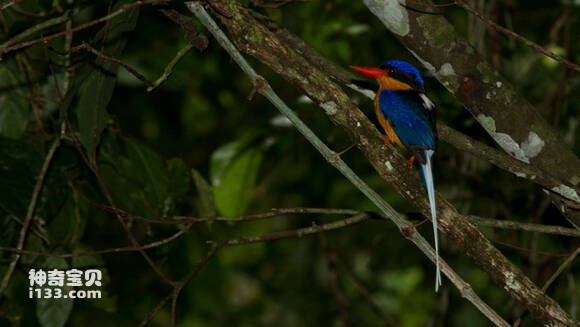Tanysiptera sylvia
IUCN
LCBasic Information
Scientific classification
- name:Tanysiptera sylvia
- Scientific Name:Tanysiptera sylvia,Buff-breasted paradise kingfisher
- Outline:Climbing birds
- Family:
Vital signs
- length:30-35cm
- Weight:43-74g
- lifetime:No textual research information is available
Feature
It is the only bird in the kingfisher family with a long, ribbon-like tail
Distribution and Habitat
The white-tailed emerald is found on the northern coast of Australia and New Guinea.
The white-tailed emerald is commonly found in lowland forests, along hills up to 900 m high and even 1560 m high.
Appearance
The white tail fairy jade is 30-35 cm long and 43-74 g in weight. Forehead, eyes first black, black eye stripes, crown and shoulders bright blue, neck and upper back black. The upper body is black, the abdomen is apricot, the rump is white, the mouth is red, the iris is dark brown, and the legs are orange. There are two very long white tail feathers.
Details
Tanysiptera sylvia, Buff-breasted paradise kingfisher, has 4 subspecies.

A completely carnivorous kingfisher, its hunting techniques are roughly the same as those of other species of hunting kingfishers, but it also has its own characteristics. Often hidden in the shade of the tree near the water to prey on fish and shrimp. His head hardly moves while he stands, and his tail wags from time to time. It spends most of its time on the ground searching for food, digging through the soil with its mouth to prey on insects, including snails, beetles, grasshoppers, caterpillars, centipedes, earthworms, and small reptile lizards. Sometimes it makes the feathers very dirty.
The breeding season varies from place to place, from May, June and December in the United Kingdom to February in Papua New Guinea and November, December and January in Queensland and New Britain. In the white tail fairy jade nest is generally built more than 5 meters above the ground in the tree hole. However, in Australia and New Guinea, termite towers are also built, and there are also in trees, but most commonly a nest is dug in an earth dam, 15 to 20 cm. The female lays three eggs, and both parents take turns to incubate and raise the chicks together.

Listed in the International Union for Conservation of Nature (IUCN) ver 3.1:2008 Red List of Birds: Not threatened.
Protect wild animals and eliminate wild meat.
Maintaining ecological balance is everyone's responsibility!








